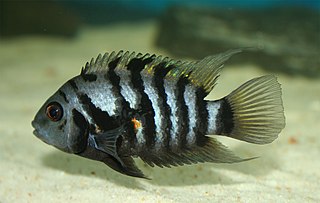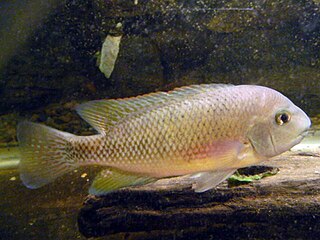
Cichlids are fish from the family Cichlidae in the order Cichliformes. Traditionally Cichlids were classed in a suborder, the Labroidei, along with the wrasses (Labridae), in the order Perciformes, but molecular studies have contradicted this grouping. On the basis of fossil evidence, it first appeared in Argentina during the Early Eocene epoch, about 48.6 million years ago; however, molecular clock estimates have placed the family's origin as far back as 67 million years ago, during the late Cretaceous period. The closest living relative of cichlids is probably the convict blenny, and both families are classified in the 5th edition of Fishes of the World as the two families in the Cichliformes, part of the subseries Ovalentaria. This family is large, diverse, and widely dispersed. At least 1,650 species have been scientifically described, making it one of the largest vertebrate families. New species are discovered annually, and many species remain undescribed. The actual number of species is therefore unknown, with estimates varying between 2,000 and 3,000.

Cichlasoma is a genus of freshwater fish in the cichlid family. The genus was previously very large, including cichlids from North America, including Central America, and South America.

The green terror is a colorful freshwater fish in the cichlid family. The fish originates from the Pacific side of South America from the Tumbes River in Peru to the Esmeraldas River in Ecuador. It is polymorphic and can have white or gold-orange edging to the tail and dorsal fins. It has historically been confused with two other species that always have narrow, clearly defined white edging, the more southerly distributed A. stalsbergi and the more northerly A. blombergi.

The convict cichlid is a fish species from the family Cichlidae, native to Central America, also known as the zebra cichlid. Convict cichlids are popular aquarium fish and have also been the subject of numerous studies on fish behaviour.

Mayaheros urophthalmus, also known as the Mayan cichlid or Mexican mojarra is a species of cichlid.
Paraneetroplus is a genus of cichlid fish native to moderately to fast-flowing waters in the Coatzacoalcos, Grijalva and Papaloapan river basins in southern Mexico. They reach up to 20–25.5 cm (8–10 in) in length.
Theraps is a genus of cichlid fish that includes only a single species, the Arroya ciclid from fast-flowing rivers and streams in the Usumacinta and Polochic basins of southern Mexico and Guatemala. It is a medium-sized cichlid, up to 19 cm (7.5 in) in standard length.

Thorichthys is a genus of cichlid fish that is native to the Atlantic slope of Middle America, ranging from southern Veracruz and the Yucatán Peninsula in Mexico, to Guatemala and Honduras, with introduced populations in a few other countries. They tend to inhabit moderately-flowing to standing water such as rivers, streams, lakes, ditches and lagoons, and they are primarily freshwater fish, although T. helleri and T. meeki may occur in slightly brackish habitats.

Vieja is a genus of cichlid fish from Central America and Mexico. The majority of the species are freshwater fish found in stagnant or slow-moving waters of southern Mexico to El Salvador, but V. maculicauda, which also occurs in brackish waters, ranges south to Panama. They are high-bodied cichlids that reach lengths of up to 17–35 cm (7–14 in) depending on the exact species. Vieja feed mostly on vegetable matter, but may also take small invertebrates.

Archocentrus is a genus of cichlid fish from Central America. It currently contains a single species, the flier cichlid, which is found in stagnant and slow-moving freshwater habitats such as lakes, ponds, ditches, swamps and rivers in Honduras, Nicaragua and Costa Rica. It is up to 11 cm (4.3 in) long and feeds on invertebrates and detritus.

Herotilapia multispinosa also known as the rainbow cichlid is a Central American freshwater fish of the cichlid family. It is found on the Atlantic slope of Honduras, Nicaragua, and Costa Rica from Patuca River (Honduras) south to Matina River, and on the Pacific slope of Nicaragua and Costa Rica from Guasaule River south to Tempisque River. Specimens are also reported from the Choluteca River on the Pacific side of Honduras. This species is found in lakes and swamps with muddy bottoms, where it uses its specialized teeth and only 3.5% jaw protrusion to feed mostly on algae. It is commercially important as an aquarium fish. The rainbow cichlid prefers a pH range of 7.0–8.0, water hardness of 9-20 dGH and a temperature range of 21–36 °C.

Amatitlania is a genus of cichlid fishes native to freshwater habitats in Central America from El Salvador and Guatemala to Panama. They are fairly small cichlids, typically reaching up to 6.4–10 cm (2.5–4 in) in standard length depending on exact species, although captives may grow larger.

Heroini is a fish tribe from the Cichlasomatinae subfamily in the family Cichlidae (cichlids). All cichlids native to the Greater Antilles, United States, Mexico and northern Central America are members of this tribe. It also includes most cichlid species in southern Central America and several species from South America. A large percentage of its species were formerly placed in the genus Cichlasoma but have since been moved to other genera.

Maskaheros is a genus of cichlids fish found on Atlantic slope of southern Mexico and Guatemala in the Coatzacoalcos and Usumacinta River drainages. They are relatively large, high-bodied cichlids and were formerly included in the genus Paraneetroplus or Vieja.
Kihnichthys ufermanni, the Usumacinta cichlid, is a species of cichlid found in a few rivers in the Usumacinta River basin in Guatemala and southern Mexico. It typically occurs in rivers that are about 10–50 m (33–164 ft) wide, fairly deep, have few or no aquatic plants, and a variable water current. This species is the only known member of its genus, but several of its features, including the chisel-like teeth, are shared with Cincelichthys and whether they should be merged into a single genus is not yet fully resolved; a review in 2020 recommended that the Usumacinta cichlid should be moved into Cincelichthys. The Usumacinta cichlid reaches a standard length of 25 cm (10 in).

Cincelichthys is a genus of high-bodied cichlids found in southern Mexico to Guatemala, where they inhabit lakes, rivers and other freshwater habitats. They are large cichlids, up to 35–42.5 cm (14–17 in) long depending on species, with females reaching smaller sizes than males.
The Montecristo cichlid is a species of freshwater fish from the Atlantic slope of southern Mexico and Guatemala. This cichlid occurs in lagoons, creeks and rivers with slight to moderate current in the Grijalva–Usumacinta, Candelaria, Champotón and Coatzacoalcos river drainages. It is currently recognized as the only species in its genus, but it is closely related to –and possibly should be merged into– Vieja. The Montecristo cichlid reaches up to 24 cm (9.4 in) in standard length.
Chiapaheros grammodes is a species of cichlid fish found in the upper part of the Grijalva River basin in southern Mexico and far western Guatemala. Adults generally inhabit areas with moderate to strong current, but they can also be found in backwaters and juveniles generally occur in calm waters. This species is the only known member of its genus, but historically it has been placed in several other genera. It reaches up to about 20 cm (8 in) in standard length. C. grammodes is relatively aggressive and quite predatory, tending towards piscivory. Both natural and aquarium hybrids have occurred between this species and Vieja hartwegi.

Talamancaheros is a genus of cichlid fish found in fast- and moderately-flowing rivers on the Pacific slope of the Talamanca mountains of Costa Rica and western Panama. Talamancaheros reaches up to 25 cm (10 in) in standard length.

Chuco is a genus of medium-sized cichlid fishes from moderately to fast-flowing rivers and streams on the Atlantic slope of southern Mexico and northern Central America.
















